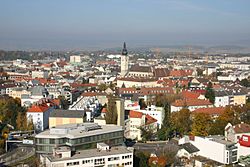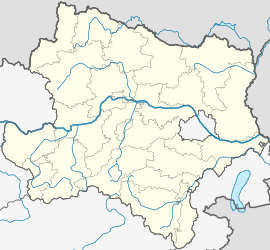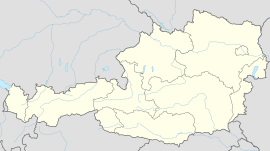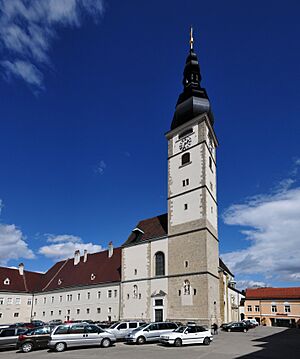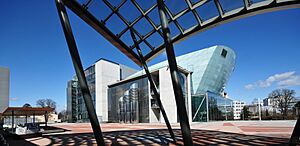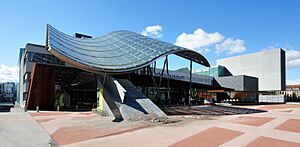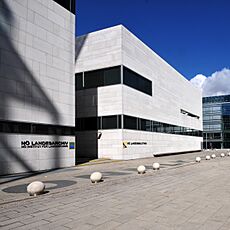Sankt Pölten facts for kids
Quick facts for kids
Sankt Pölten
|
|||
|---|---|---|---|
|
From top down, left to right: Rathausplatz with Franciscan Church and Monastery, Sankt Pölten Cathedral, view of the city, City Hall, Lower Austrian Government Quarter
|
|||
|
|||

Location of St. Pölten within Lower Austria
|
|||
| Country | |||
| State | |||
| District | Statutory city | ||
| Area | |||
| • Total | 108.44 km2 (41.87 sq mi) | ||
| Elevation | 267 m (876 ft) | ||
| Time zone | UTC+1 (CET) | ||
| • Summer (DST) | UTC+2 (CEST) | ||
| Postal code |
3100, 3104, 3105, 3106, 3107, 3108, 3140, 3151, 3385
|
||
| Area code | 02742 | ||
| Vehicle registration | P | ||
Sankt Pölten, often called St. Pölten, is the capital city of Lower Austria, a state in northeast Austria. It is the largest city in Lower Austria, with about 55,538 people living there as of January 1, 2020. St. Pölten is a special kind of city in Austria, called a Statutarstadt. This means it acts as both a city and a district at the same time. Because of its interesting culture, many visitors now pass through St. Pölten on their way to Vienna.
Contents
Geography
The city of St. Pölten is located on the Traisen River. It sits north of the Alps mountains and south of the Wachau valley. It is part of the Mostviertel, which is the southwest area of Lower Austria.
Transport
St. Pölten is a major hub for travel. The city's main train station, St. Pölten Hauptbahnhof, is on the main West railway line. It is also the starting point for several other train lines, including the Mariazellerbahn.
The city is also easy to reach by car. It is where the Western Motorway A1 and the Kremser Speedway S33 meet. The Vienna Road B1 also runs through the city. St. Pölten is a central point for the Wieselbus bus lines, which connect the capital city to different parts of Lower Austria.
Getting around the city
From 1911 to 1976, St. Pölten had a tram system. Today, there are eleven bus lines that run regularly throughout the city. In the summer, a free tourist train runs in the city center. It connects the old parts of the city with the modern government area.
Climate
| Climate data for Sankt Pölten (1991–2020) | |||||||||||||
|---|---|---|---|---|---|---|---|---|---|---|---|---|---|
| Month | Jan | Feb | Mar | Apr | May | Jun | Jul | Aug | Sep | Oct | Nov | Dec | Year |
| Record high °C (°F) | 17.9 (64.2) |
19.2 (66.6) |
24.3 (75.7) |
30.9 (87.6) |
32.2 (90.0) |
37.7 (99.9) |
37.6 (99.7) |
38.2 (100.8) |
34.2 (93.6) |
28.0 (82.4) |
23.6 (74.5) |
16.4 (61.5) |
37.7 (99.9) |
| Mean daily maximum °C (°F) | 2.5 (36.5) |
5.3 (41.5) |
10.0 (50.0) |
16.5 (61.7) |
20.1 (68.2) |
24.5 (76.1) |
25.7 (78.3) |
25.4 (77.7) |
20.5 (68.9) |
13.8 (56.8) |
7.9 (46.2) |
3.2 (37.8) |
14.6 (58.3) |
| Daily mean °C (°F) | 0.2 (32.4) |
1.7 (35.1) |
6.0 (42.8) |
11.0 (51.8) |
15.4 (59.7) |
19.0 (66.2) |
20.9 (69.6) |
20.6 (69.1) |
15.8 (60.4) |
10.5 (50.9) |
5.3 (41.5) |
1.0 (33.8) |
10.6 (51.1) |
| Mean daily minimum °C (°F) | −2.2 (28.0) |
−1.6 (29.1) |
1.6 (34.9) |
5.6 (42.1) |
9.6 (49.3) |
13.6 (56.5) |
14.7 (58.5) |
14.5 (58.1) |
11.0 (51.8) |
6.4 (43.5) |
2.6 (36.7) |
−1.2 (29.8) |
6.2 (43.2) |
| Record low °C (°F) | −22.1 (−7.8) |
−20.7 (−5.3) |
−23.1 (−9.6) |
−4.3 (24.3) |
0.6 (33.1) |
2.9 (37.2) |
6.8 (44.2) |
7.0 (44.6) |
1.1 (34.0) |
−6.9 (19.6) |
−13.4 (7.9) |
−20.0 (−4.0) |
−23.1 (−9.6) |
| Average precipitation mm (inches) | 31.8 (1.25) |
25.9 (1.02) |
45.5 (1.79) |
45.4 (1.79) |
93.7 (3.69) |
105.7 (4.16) |
102.8 (4.05) |
101.4 (3.99) |
74.5 (2.93) |
50.9 (2.00) |
41.1 (1.62) |
33.7 (1.33) |
752.4 (29.62) |
| Average snowfall cm (inches) | 16 (6.3) |
17 (6.7) |
8 (3.1) |
2 (0.8) |
0 (0) |
0 (0) |
0 (0) |
0 (0) |
0 (0) |
0 (0) |
6 (2.4) |
14 (5.5) |
64 (25) |
| Average relative humidity (%) (at 14:00) | 78.3 | 69.4 | 60.0 | 52.2 | 55.2 | 55.2 | 54.3 | 54.2 | 60.0 | 68.4 | 77.6 | 80.6 | 63.8 |
| Mean monthly sunshine hours | 60.0 | 92.0 | 146.3 | 203.0 | 230.9 | 243.7 | 253.3 | 251.7 | 179.6 | 123.8 | 62.6 | 50.3 | 1,897.2 |
| Percent possible sunshine | 23.2 | 33.1 | 40.4 | 50.3 | 50.1 | 52.0 | 53.7 | 58.1 | 48.7 | 38.0 | 23.9 | 20.6 | 41.0 |
| Source: Central Institute for Meteorology and Geodynamics (snowfall 1981-2010) | |||||||||||||
| Climate data for Sankt Pölten (1971–2000) | |||||||||||||
|---|---|---|---|---|---|---|---|---|---|---|---|---|---|
| Month | Jan | Feb | Mar | Apr | May | Jun | Jul | Aug | Sep | Oct | Nov | Dec | Year |
| Record high °C (°F) | 16.2 (61.2) |
19.2 (66.6) |
25.6 (78.1) |
27.3 (81.1) |
30.8 (87.4) |
34.9 (94.8) |
37.0 (98.6) |
38.2 (100.8) |
33.8 (92.8) |
26.9 (80.4) |
23.4 (74.1) |
14.6 (58.3) |
38.2 (100.8) |
| Mean daily maximum °C (°F) | 1.8 (35.2) |
4.0 (39.2) |
9.7 (49.5) |
14.5 (58.1) |
20.3 (68.5) |
22.8 (73.0) |
25.0 (77.0) |
25.1 (77.2) |
20.1 (68.2) |
14.0 (57.2) |
6.5 (43.7) |
3.0 (37.4) |
13.9 (57.0) |
| Daily mean °C (°F) | −1 (30) |
0.4 (32.7) |
4.7 (40.5) |
8.9 (48.0) |
14.3 (57.7) |
17.2 (63.0) |
19.1 (66.4) |
18.9 (66.0) |
14.5 (58.1) |
9.1 (48.4) |
3.5 (38.3) |
0.4 (32.7) |
9.2 (48.6) |
| Mean daily minimum °C (°F) | −3.3 (26.1) |
−2.3 (27.9) |
1.1 (34.0) |
4.4 (39.9) |
9.2 (48.6) |
12.3 (54.1) |
14.1 (57.4) |
14.0 (57.2) |
10.6 (51.1) |
5.9 (42.6) |
1.3 (34.3) |
−1.7 (28.9) |
5.5 (41.9) |
| Record low °C (°F) | −22.1 (−7.8) |
−20.7 (−5.3) |
−23.1 (−9.6) |
−4.8 (23.4) |
−0.9 (30.4) |
2.4 (36.3) |
6.8 (44.2) |
5.6 (42.1) |
1.3 (34.3) |
−6.9 (19.6) |
−13.4 (7.9) |
−20 (−4) |
−23.1 (−9.6) |
| Average precipitation mm (inches) | 29.5 (1.16) |
31.9 (1.26) |
42.1 (1.66) |
53.4 (2.10) |
73.5 (2.89) |
82.9 (3.26) |
88.1 (3.47) |
75.7 (2.98) |
56.3 (2.22) |
38.1 (1.50) |
48.9 (1.93) |
38.6 (1.52) |
659.0 (25.94) |
| Average snowfall cm (inches) | 18.1 (7.1) |
16.5 (6.5) |
10.1 (4.0) |
4.0 (1.6) |
0.0 (0.0) |
0.0 (0.0) |
0.0 (0.0) |
0.0 (0.0) |
0.0 (0.0) |
0.1 (0.0) |
7.4 (2.9) |
17.1 (6.7) |
73.3 (28.9) |
| Average precipitation days (≥ 1.0 mm) | 7.2 | 7.2 | 7.9 | 8.5 | 9.2 | 10.5 | 10.7 | 9.0 | 7.6 | 6.5 | 9.0 | 8.1 | 101.4 |
| Average relative humidity (%) (at 14:00) | 76.7 | 69.1 | 58.0 | 52.5 | 50.7 | 53.8 | 52.7 | 51.1 | 57.4 | 63.8 | 75.7 | 79.2 | 61.7 |
| Mean monthly sunshine hours | 55.2 | 87.4 | 129.7 | 168.8 | 224.6 | 221.9 | 234.9 | 232.5 | 165.8 | 118.3 | 58.8 | 45.4 | 1,743.3 |
| Percent possible sunshine | 22.3 | 33.6 | 38.7 | 44.4 | 50.7 | 49.3 | 51.4 | 55.5 | 47.6 | 38.6 | 23.2 | 19.3 | 39.6 |
| Source: Central Institute for Meteorology and Geodynamics | |||||||||||||
St. Pölten has a moderate climate. The weather boxes above show detailed information about the temperatures, rainfall, and sunshine throughout the year.
History
The oldest part of St. Pölten was built on the site of an ancient Roman city called Aelium Cetium. This Roman city existed between the 2nd and 4th centuries. In the year 799, the area was known as Treisma.
St. Pölten officially became a town in 1050 and then a city in 1169. For a long time, until 1494, it was part of the diocese of Passau, which is a church area. After that, it became property of the state.
A Benedictine monastery, a type of religious community, was started in 791. Later, in 1081, it became home to the Augustinian Chorherren, another religious group. Their college closed in 1784. Since 1785, this building has been the cathedral of St. Pölten.
A big change happened on July 10, 1986. The parliament of Lower Austria decided that St. Pölten would replace Vienna as the capital city of Lower Austria. The government of Lower Austria has been based in St. Pölten since 1997.
The name St. Pölten comes from Hippolytus of Rome, a saint. The city was first called Sankt Hippolyt, then St Polyt, and finally St Pölten.
Economy
St. Pölten is an active city with many businesses. As of May 15, 2001, over 40,000 people worked in more than 2,700 companies in the city. Among these, 23 are large businesses with over 200 employees each.
Media
Several media companies are located in St. Pölten:
- "@cetera": A magazine about literature and culture.
- "City-Flyer": An online magazine about cultural events, also printed monthly.
- "Campus Radio": A radio station from the University of Applied Sciences.
- "HiT FM": A radio station that broadcasts in Lower Austria.
- "LetHereBeRock": An online magazine for young people about alternative rock music.
- NÖN: A newspaper for Lower Austria.
- The Austrian Broadcasting Corporation for Lower Austria.
- "P3tv": A local television channel.
Large-scale enterprises
Some of the biggest companies in St. Pölten include:
- Leiner: A company that makes furniture.
- Salzer: A company that produces paper.
- Voith: A family-owned engineering company.
Public facilities
Educational facilities
St. Pölten has many schools and places for learning:
- Bundesgymnasium and Bundesrealgymnasium St. Pölten: Public high schools.
- Public educational facility for kindergarten and social pedagogy: For training teachers and social workers.
- Public economics school and economics academy: For business studies.
- Bundesreal- and Bundesoberstufenrealgymnasium (BORG) Schulring: Another public high school.
- St. Pölten University of Applied Sciences: Offers studies in computer simulation, media management, social work, and telecommunication.
- Public higher educational facility for economics and social professions.
- Public higher technical educational facility and laboratory: For fields like computer science, electronics, and engineering. It also has a university of applied sciences for machine construction.
- New Design University: Focuses on interior architecture and graphics design.
- Lower Austrian state academy.
- Philosophical-theological university.
- Folk high school: Offers adult education.
- Lower Austrian institute for promotion of economy development (WIFI).
Leisure and sports sites
There are many places for fun and sports in St. Pölten:
- Aquacity: An indoor swimming pool.
- St. Pölten outdoor swimming pool.
- Ratzersdorf Lake: For swimming and other water activities.
- Fitness centers like City-Treff - Pueblo, Lifeline, Reebok, and Seepark.
- American Football Club - St. Pölten Invaders.
- Badminton Club.
- Golf club St. Pölten.
- Skittles at Megafun leisure park.
- Miniature golf at the Tennis-Allround Center.
- Model aircraft airport of the BSV VOITH.
- Riding club St. Pölten-Wagram.
- Shooting range of the private Schützenkompagnie.
- Skatepark.
- Gliding club St. Pölten.
St. Pölten is also home to the main base of the Lower Austrian state sports school.
Tennis
Every year in May, St. Pölten hosts an ATP tennis tournament. The city has several tennis stadiums and courts, including the Arena im Aufeld and courts at the Lower Austrian state sports school.
International relations
St. Pölten has "twin town" or "sister city" relationships with other cities around the world. This means they share cultural and educational exchanges.
 Altoona, Pennsylvania, USA
Altoona, Pennsylvania, USA Brno, Czech Republic
Brno, Czech Republic Clichy, Hauts-de-Seine, Île-de-France, France
Clichy, Hauts-de-Seine, Île-de-France, France Heidenheim, Baden-Württemberg, Germany
Heidenheim, Baden-Württemberg, Germany Kurashiki, Japan
Kurashiki, Japan Nyíregyháza, Hungary
Nyíregyháza, Hungary Wuhan, China
Wuhan, China
Culture and objects of interest
Theatres
- Lower Austrian state theatre
- Bühne im Hof
- Festspielhaus St. Pölten
Museums
- Diocese museum St. Pölten
- Museum im Hof
- Lower Austrian state museum
- Lower Austrian documentation institute for modern art
- Private museum "Wilhelmsburger ornament and utensil dishes"
- City museum St. Pölten
Other interesting places
- Cinema Paradiso: A repertory theatre.
- Former synagogue.
- Klangturm: A tall tower that is a symbol of the city.
- Stadtsäle: A public hall for events.
- Youth culture hall frei.raum.
- VAZ (Veranstaltungszentrum): A large event center.
- Drunter & Drüber: A popular pub in the city center.
- Tonkünstler Orchestra: A famous orchestra.
- Business Center Niederösterreich.
- Apotheke zum goldenen Löwen: A pharmacy that has been open since 1545, known for its beautiful baroque front.
Regular events
St. Pölten hosts many events throughout the year:
- ATP tennis tournament.
- Cinema at the cathedral (Film am Dom).
- Capital city festival.
- International culture and film festival.
- Parliament festival.
- St. Pölten festival weeks "Klangweile".
- St. Pölten Höfefest.
- FM4 Frequency Festival.
- Pro Golf Tour tournament.
Notable people
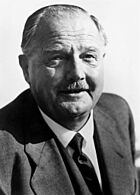
Many famous people have connections to St. Pölten:
- Jakob Prandtauer (1660-1726): An Austrian Baroque architect.
- Ernst Stöhr (1860–1917): A painter, graphic artist, and writer.
- Julius Raab (1891–1964): A conservative politician and former Chancellor of Austria.
- Walter Fischer (1901–1978): A doctor, journalist, and resistance fighter.
- Maria Emhart (1901-1981): A resistance activist and national politician.
- Otto Demus (1902-1990): An art historian.
- Walter Graf (1903–1982): A musicologist.
- Heinrich Maier (1908–1945): A priest and resistance fighter against Nazi Germany.
- Bernhard Wicki (1919–2000): An Austrian-Swiss actor and film director.
- Karl Österreicher (1923–1995): A conductor and music educator.
- Peter Minich (1927–2013): A stage actor and tenor singer.
- Jörg Demus (1928–2019): An Austrian classical pianist.
- Lolita (1931–2010): A singer and actress.
- Erwin Leder (born 1951): An actor known for films like Das Boot.
- Alfred Gusenbauer (born 1960): A politician and former Chancellor of Austria.
- Martin Fiala (born 1961): An Austrian composer.
- Oliver Stummvoll (born 1995): A model.
- The Clairvoyants (founded 2011): A magic and mentalist duo.
Sport
- Franz Binder (1911–1989): A famous footballer and coach.
- Karl Daxbacher (born 1953): A football manager and player.
- Jochen Fallmann (born 1979): A football coach and former player.
- Markus Wagesreiter (born 1982): A handball player for Austria.
- Lukas Mössner (born 1984): A footballer.
- Maria Gstöttner (born 1984): A football striker for Austria women's team.
- Benjamin Karl (born 1985): A snowboarder with Olympic medals.
See also
 In Spanish: Sankt Pölten para niños
In Spanish: Sankt Pölten para niños




